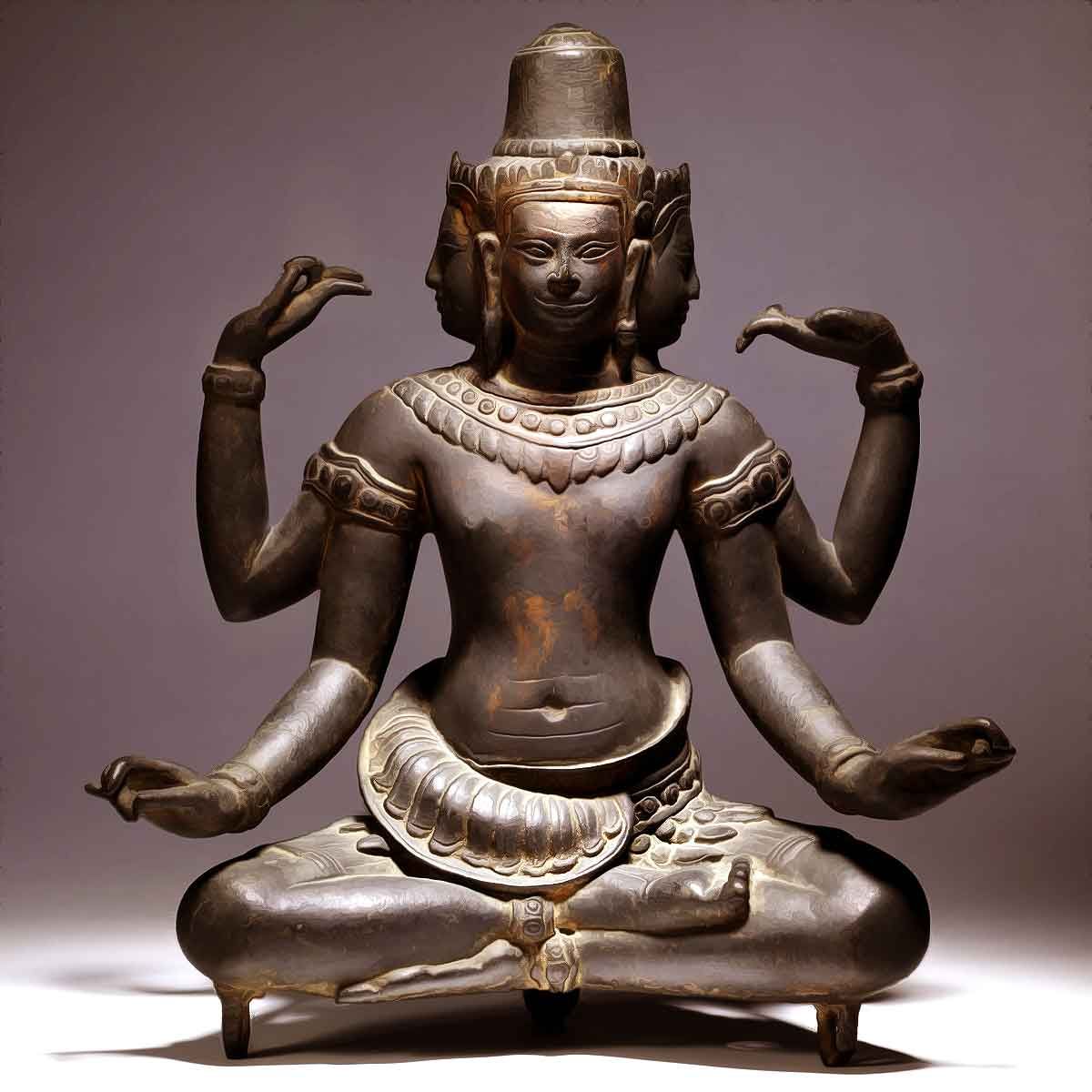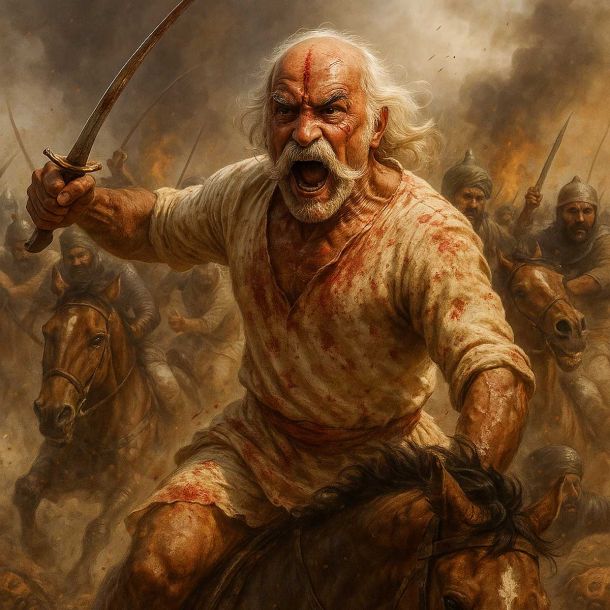MORE COVERAGE
Sculpture of seated Brahma of Angkor in Cambodia was most likely made during the reign of the Buddhist King Jayavarman VII (r. 1181-ca. 1218), when many Hindu deities were incorporated into the practices of Khmer Buddhism

The god Brahma is best known for his role in the Hindu pantheon as the creator of the universe, but he also has a place in the Buddhist traditions as a protector of the "dharma" (Buddhist teachings).
|
This sculpture was most likely made during the reign of the Buddhist king Jayavarman VII (r. 1181-ca. 1218) when many Hindu deities were incorporated into the practices of Khmer Buddhism. Brahma's four faces, which look in all four directions at once, signal his omniscience.
- Cambodian (Artist)
- Late 12th-early 13th century (Bàyon)
- Bronze (Southeast Asia )
Hinduism perceives the whole creation and its cosmic activity as the work of three fundamental forces symbolized by three gods, which constitutes the Hindu Trinity or ‘Trimurti’: Brahma — the creator, Vishnu — the sustainer, and Shiva — the destroyer.
Brahma, the Creator
Brahma is the creator of the universe and of all beings, as depicted in the Hindu cosmology. The Vedas, the oldest and the holiest of Hindu scriptures are attributed to Brahma, and thus Brahma is regarded as the father of dharma. He is not to be confused with Brahman which is a general term for the Supreme Being or Almighty God. Although Brahma is one of the Trinity, his popularity is no match to that of Vishnu and Shiva. Brahma is to be found to exist more in scriptures than in homes and temples. In fact, it is hard to find a temple dedicated to Brahma. One such temple is located in Pushkar in Rajasthan.
The Birth of Brahma
According to the Puranas, Brahma is the son of God and is often referred to as Prajapati. The Shatapatha Brahman says that Brahma was born of the Supreme Being Brahman and the female energy known as Maya. Wishing to create the universe, Brahman first created the water, in which he placed his seed. This seed transformed into a golden egg, from which Brahma appeared. For this reason, Brahma is also known as ‘Hiranyagarbha’.
According to another legend, Brahma is self-born out of a lotus flower that grew from the navel of Vishnu. In order to help him create the universe, Brahma gave birth to the 11 forefathers of the human race called ‘Prajapatis’ and the seven great sages or the ‘Saptarishi’. These children or mind-sons of Brahma, who were born out of his mind rather than the body, are called the ‘Manasputras’.
|
The Symbolism of Brahma in Hinduism
In the Hindu pantheon, Brahma is commonly represented as having four heads, four arms, and red skin. Unlike all the other Hindu gods, Brahma carries no weapon in his hands. He holds a water pot, a spoon, a book of prayers or the Vedas, a rosary, and sometimes a lotus. He sits on a lotus in the lotus pose and moves around on a white swan, possessing the magical ability to separate milk from a mixture of water and milk. Brahma is often depicted as having a long, white beard, with each of his heads reciting the four Vedas.
Brahma, Cosmos, Time, and Epoch
Brahma presides over 'Brahmaloka,' a universe that contains all the splendors of the earth and all other worlds. In Hindu cosmology, the universe exists for a single day called the ‘Brahmakalpa’. This day is equivalent to four billion earth years, at the end of which the whole universe gets dissolved. This process is called ‘pralaya’, which repeats for such 100 years, a period that represents Brahma's lifespan. After Brahma's "death", it is necessary that another 100 of his years pass until he is reborn and the whole creation begins anew.
Linga Purana, which delineates the clear calculations of the different cycles, indicates that Brahma's life is divided into one thousand cycles or ‘Maha Yugas’.
Brahma in American Literature
Ralph Waldo Emerson (1803-1882) wrote a poem called "Brahma" that was published in the Atlantic in 1857, which shows many ideas from Emerson's reading of Hindu scriptures and philosophy. He interpreted Brahma as an "unchanging reality" in contrast to Maya, "the changing, illusory world of appearance." Brahma is infinite, serene, invisible, imperishable, immutable, formless, one, and eternal, said Arthur Christy (1899 – 1946), the American author and critic.
|
Provenance
Brahmanical Temple (Bot Phram), Bangkok; Alexander B. Griswold, Monkton, Maryland, July 1949 [1]; by bequest to Walters Art Museum, 1992.
[1] Presented to the Breezewood Foundation, December 1960, inv. no. 490 (originally no. 863)
Exhibitions
1995 | Unearthly Elegance: Buddhist Art from the Griswold Collection. The Walters Art Gallery, Baltimore.
References:
 Support Us
Support Us
Satyagraha was born from the heart of our land, with an undying aim to unveil the true essence of Bharat. It seeks to illuminate the hidden tales of our valiant freedom fighters and the rich chronicles that haven't yet sung their complete melody in the mainstream.
While platforms like NDTV and 'The Wire' effortlessly garner funds under the banner of safeguarding democracy, we at Satyagraha walk a different path. Our strength and resonance come from you. In this journey to weave a stronger Bharat, every little contribution amplifies our voice. Let's come together, contribute as you can, and champion the true spirit of our nation.
 |  |  |
| ICICI Bank of Satyaagrah | Razorpay Bank of Satyaagrah | PayPal Bank of Satyaagrah - For International Payments |
If all above doesn't work, then try the LINK below:
Please share the article on other platforms
DISCLAIMER: The author is solely responsible for the views expressed in this article. The author carries the responsibility for citing and/or licensing of images utilized within the text. The website also frequently uses non-commercial images for representational purposes only in line with the article. We are not responsible for the authenticity of such images. If some images have a copyright issue, we request the person/entity to contact us at This email address is being protected from spambots. You need JavaScript enabled to view it. and we will take the necessary actions to resolve the issue.
Related Articles
- "Pure devotion is a vessel for divine grace": Envision a monumental statue of Lord Ram, reaching skywards to a staggering 108 feet! This grand spectacle, representing millennia-old Vaishnava tradition will grace Andhra Pradesh's Kurnool district
- "Nataraj, Nataraja, Jai Shiva Shankara Nataraja": One of mystical forms of Lord Shiva ‘Nataraj that represents the Lord’s cosmic dance that symbolizes both the destruction and the creation of the universe, revealing the cycles of death and birth
- "Movement of formless to form - Shivalinga": Supreme manifested as God through a threefold manifestation of Shaiva iconography, first manifestation Para-Shiva, second Sadashiva and third Mahesha, iconography started during Kushan period
- Calcutta High Court's landmark judgment illuminates the secular essence of Durga Puja, reinforcing citizens' constitutional rights and India's unity in diversity, a celebration beyond religion, it embodies vibrant spirit of communal harmony & tradition
- Construction of Ram Mandir in Ayodhya is in full flow with the foundation work finished, main contractor for construction is Larsen & Toubro while Tata Consulting Engineers are project management consultant
- "The soul has this proof of divinity: that divine things delight it": Journey into the Realm of Transcendence: Discover the Mystical Presence of Gudimallam Sacred Shivling where every 60 years the main chamber becomes engulfed in a flood, defying nature
- "Dekh raha hai Binod, sab Gyanvapi Shivling bhul gaye": Rajesh Mani Tripathi, president of Shri Krishana Janma Bhumi Mukti Sthal filed petition in Supreme Court to perform religious rituals for Shivling at Gyanvapi since the month of ‘Shravana’ starting
- Petitioner in Shri Krishna Janmasthan-Shahi Idgah Masjid dispute filed a plea seeking permission to perform ‘purification’ of the Shahi Idgah complex, says the site is sanctum sanctorum of Thakur Keshav Dev temple
- "In the light of devotion, every sacrifice becomes a joy": For the first time beyond borders, the sacred Kanwar Yatra commenced in Tokyo, a spiritual journey to offer sacred Gangajal from Bihar's Sultanganj to Bholenath in the auspicious month of Sawan
- "Where snakes are family, fear sheds its skin": Maharashtra, in Shetpal village cobras roam freely amongst residents, a unique testament to India's deep-rooted harmony with nature, challenging perceptions and captivating visitors with its serpentine charm
- Why look for Shivling in every mosque: RSS chief Mohan Bhagwat on Gyanvapi says 'it is a matter of faith for Hindus, issue should be settled amicably', but advises against opening battles in every mosque
- "ॐ तत्पुरुषाय विद्महे महादेवाय धीमहितन्नो रुद्रः प्रचोदयात्": Ancients raising again - A dream helped in discovery of 1000 year old massive 6ft Shivalingam on auspicious day of Deepavali at Arasampalayam, TN near sangam of Amaravathy & Kudakunaaru rivers
- "Faith moves mountains, and stones tell tales": Omkareshwar to Ayodhya - A journey not just of distance but of deep-rooted faith, carved from the sacred Narmada waters, the 600kg Narmadeshwar Shivling's odyssey resonates the hymns of billions in unison
- "त्रय: शूलनिर्मूलनं शूलपाणिं। भजेऽहं भवानीपतिं भावगम्यं": 3 Shivling unearthed at Kanpur Central railway station, a pair of snakes were also present there, but soon disappeared, locals of the area thronged the site and started chanting 'Har Har Mahadev'
- "Temple will be an ever-present reminder that God intended the family to be eternal": Thirunakkara Mahadevar Temple situated in the heart of Kottayam is one of the 108 revered Shivalayas in Kerala, preserves sculptures and murals of Hindu deities












